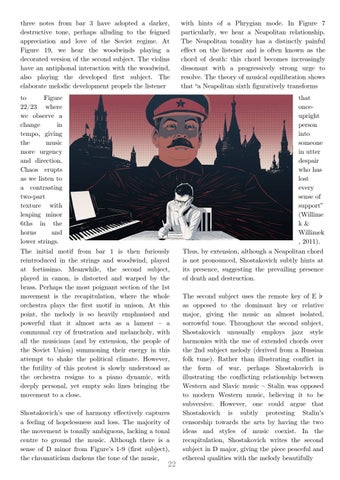three notes from bar 3 have adopted a darker, destructive tone, perhaps alluding to the feigned appreciation and love of the Soviet regime. At Figure 19, we hear the woodwinds playing a decorated version of the second subject. The violins have an antiphonal interaction with the woodwind, also playing the developed first subject. The elaborate melodic development propels the listener to Figure 22/23 where we observe a change in tempo, giving the music more urgency and direction. Chaos erupts as we listen to a contrasting two-part texture with leaping minor 6ths in the horns and lower strings.
with hints of a Phrygian mode. In Figure 7 particularly, we hear a Neapolitan relationship. The Neapolitan tonality has a distinctly painful effect on the listener and is often known as the chord of death: this chord becomes increasingly dissonant with a progressively strong urge to resolve. The theory of musical equilibration shows that “a Neapolitan sixth figuratively transforms that onceupright person into someone in utter despair who has lost every sense of support” (Willime k& Willimek , 2011).
The initial motif from bar 1 is then furiously reintroduced in the strings and woodwind, played at fortissimo. Meanwhile, the second subject, played in canon, is distorted and warped by the brass. Perhaps the most poignant section of the 1st movement is the recapitulation, where the whole orchestra plays the first motif in unison. At this point, the melody is so heavily emphasised and powerful that it almost acts as a lament – a communal cry of frustration and melancholy, with all the musicians (and by extension, the people of the Soviet Union) summoning their energy in this attempt to shake the political climate. However, the futility of this protest is slowly understood as the orchestra resigns to a piano dynamic, with deeply personal, yet empty solo lines bringing the movement to a close. Shostakovich’s use of harmony effectively captures a feeling of hopelessness and loss. The majority of the movement is tonally ambiguous, lacking a tonal centre to ground the music. Although there is a sense of D minor from Figure’s 1-9 (first subject), the chromaticism darkens the tone of the music,
22
Thus, by extension, although a Neapolitan chord is not pronounced, Shostakovich subtly hints at its presence, suggesting the prevailing presence of death and destruction.
♭
The second subject uses the remote key of E as opposed to the dominant key or relative major, giving the music an almost isolated, sorrowful tone. Throughout the second subject, Shostakovich unusually employs jazz style harmonies with the use of extended chords over the 2nd subject melody (derived from a Russian folk tune). Rather than illustrating conflict in the form of war, perhaps Shostakovich is illustrating the conflicting relationship between Western and Slavic music – Stalin was opposed to modern Western music, believing it to be subversive. However, one could argue that Shostakovich is subtly protesting Stalin’s censorship towards the arts by having the two ideas and styles of music coexist. In the recapitulation, Shostakovich writes the second subject in D major, giving the piece peaceful and ethereal qualities with the melody beautifully











